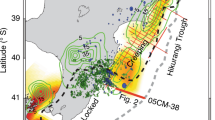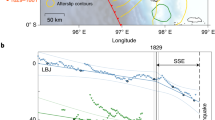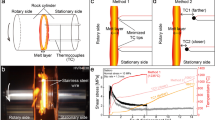Abstract
Shallow portions of faults exhibit brittle, stick–slip behaviour that gives way to more stable sliding with increasing depth, limiting the depths to which earthquake-inducing slip can occur. The increase of temperature with depth is often assumed to transform friction in the fault from velocity-weakening (unstable) to velocity-strengthening (stable), and to change conditions from brittle to ductile1,2,3,4,5. A temperature of 350 ∘C has been suggested to mark the base of the frictionally unstable portion of the fault, which becomes free slipping at depth where temperatures rise above 450 ∘C (refs 2, 4, 6). Here, we show that both slow-slip events and the geodetically observed transition from fault locking to free slip at the Hikurangi subduction zone east of the North Island, New Zealand occur at temperatures as low as 100 ∘C, suggesting that temperature is not a primary control on either slow-slip or fault-locking processes at the Hikurangi margin. Although globally shallow slow-slip events are rare, five out of seven events observed so far at the Hikurangi margin are less than 15 km deep.
This is a preview of subscription content, access via your institution
Access options
Subscribe to this journal
Receive 12 print issues and online access
$259.00 per year
only $21.58 per issue
Buy this article
- Purchase on Springer Link
- Instant access to full article PDF
Prices may be subject to local taxes which are calculated during checkout



Similar content being viewed by others
References
Scholz, C. The Mechanics of Earthquakes and Faulting 2nd edn (Cambridge Univ. Press, Cambridge, 2002).
Hyndman, R. D. & Wang, K. Thermal constraints on the zone of major thrust earthquake failure: The Cascadia subduction zone. J. Geophys. Res. 98, 2039–2060 (1993).
Wang, K., Wells, R., Mazzotti, S., Hyndman, R. D. & Sagiya, T. A revised dislocation model of interseismic deformation of the Cascadia subduction zone. J. Geophys. Res. 108, 2026 (2003).
Liu, Y. & Rice, J. R. Spontaneous and triggered aseismic deformation transients in a subduction fault model. J. Geophys. Res. 112, B09404 (2007).
Schwartz, S. Y. & Rokosky, J. M. Slow slip events and seismic tremor at circum-Pacific subduction zones. Rev. Geophys. 45doi:2006RG000208 (2007).
Oleskevich, D., Hyndman, R. D. & Wang, K. The updip and downdip limits to great subduction earthquakes: Thermal and structural models of Cascadia, S. W. Japan, Alaska, and Chile. J. Geophys. Res. 104, 14965–14991 (1999).
Dragert, H., Wang, K. & James, T. S. A silent slip event on the deeper Cascadia subduction interface. Science 292, 1525–1528 (2001).
Linde, A. T., Gladwin, M. T., Johnston, M. J. S. & Gwyther, R. L. A slow earthquake sequence on the San Andreas fault. Nature 383, 65–68 (1996).
Lowry, A. P. Resonant slow fault slip in subduction zones forced by climatic load stress. Nature 442, 802–805 (2006).
Wallace, L. M., Beavan, J., McCaffrey, R. & Darby, D. Subduction zone coupling and tectonic block rotations in the North Island, New Zealand. J. Geophys. Res. 109, B12406 (2004).
Reyners, M. Plate coupling and the hazard of large subduction thrust earthquakes at the Hikurangi subduction zone, New Zealand. N. Z. J. Geol. Geophys. 41, 343–354 (1998).
Beavan, J., Wallace, L. M., Fletcher, H. J. & Douglas, A. in Dynamic Planet: Monitoring and Understanding a Dynamic Planet with Geodetic and Oceanographic Tools, International Association of Geodesy Symposia, 130, Cairns, Australia, 22–26 August, 2005 (eds Tregoning, P. & Rizos, C.) 438–444 (Springer, Berlin, 2007).
Douglas, A., Beavan, J., Wallace, L. & Townend, J. Slow slip on the northern Hikurangi subduction interface, New Zealand. Geophys. Res. Lett. 32, L16305 (2005).
McCaffrey, R., Wallace, L., Beavan, J. & Douglas, A. Slow slip events, temperature, and interseismic coupling at the Hikurangi subduction zone, New Zealand. Eos Trans. AGU 88 (2007). Jt. Assem. Suppl. Abstract G31A-05.
Wallace, L. M. & Beavan, J. A large slow slip event on the central Hikurangi subduction interface beneath the Manawatu region, North Island, New Zealand. Geophys. Res. Lett. 33, L11301 (2006).
Molnar, P. & England, P. Temperatures in zones of steady-state underthrusting of young oceanic lithosphere. Earth Planet. Sci. Lett. 131, 57–70 (1995).
Mortimer, N. & Parkinson, D. Hikurangi Plateau; a Cretaceous large igneous province in the Southwest Pacific Ocean. J. Geophys. Res. 101, 687–696 (1996).
Ansell, J. H. & Bannister, S. C. Shallow morphology of the subducted Pacific plate along the Hikurangi margin, New Zealand. Phys. Earth Planet. Inter. 93, 3–20 (1996).
Townend, J. Estimates of conductive heat flow through bottom-simulating reflectors on the Hikurangi and southwest Fiordland continental margins, New Zealand. Mar. Geol. 141, 209–220 (1997).
Henrys, S. A., Ellis, S. & Uruski, C. Conductive heat flow variations from bottom-simulating reflectors on the Hikurangi margin, New Zealand. Geophys. Res. Lett. 30doi:10.1029/2002GL015772 (2003).
Gosnold, W. D. Jr & Panda, B. Proc. of the Fifth International Mtg, Heat Flow and Structure of the Lithosphere, Kostelec, Czechia 22 (2001) http://www.geo.lsa.umich.edu/IHFC/heatflow.html.
Grevemeyer, I., Diaz-Naveas, J. L., Ranero, C. R., Villinger, H. W. & Ocean Drilling Program Leg 202 Scientific Party. Heat flow over the descending Nazca plate in central Chile, 32∘ S to 41∘ S: Observations from ODP Leg 202 and the occurrence of natural gas hydrates. Earth Planet. Sci. Lett. 213, 285–298 (2003).
Lewis, K. B., Collot, J.-Y. & Lallemande, S. E. The dammed Hikurangi Trough: A channel-fed trench blocked by subducting seamounts and their wake avalanches (New Zealand-France GeodyNZ Project). Basin Res. 10, 441–468 (1998).
Lamb, S. Shear stresses on megathrusts: Implications for mountain building behind subduction zones. J. Geophys. Res. 111, 1–24 (2006).
Sagiya, T. Interplate coupling in the Kanto District, Central Japan, and the Boso Peninsula silent earthquake in May 1996. Pure Appl. Geophys. 161, 2327–2342 (2004).
Fournier, T. J. & Freymueller, J. T. Transition from locked to creeping subduction in the Shumagin region, Alaska. Geophys. Res. Lett. 34doi:10.1029/2006GL029073 (2007).
Rubinstein, J. L. et al. Non-volcanic tremor driven by large transient shear stresses. Nature 448, 579–582 (2007).
Arnadottir, T. S., Thornley, S., Pollitz, F. & Darby, D. Spatial and temporal strain rate variations at the northern Hikurangi margin, New Zealand. J. Geophys. Res. 104, 4931–4944 (1999).
Doser, D. I. & Webb, T. H. Source parameters of large historical (1917–1961) earthquakes, North Island, New Zealand. Geophys. J. Int. 152, 795–832 (2003).
Beavan, J., Tregoning, P., Bevis, M., Kato, T. & Meertens, C. Motion and rigidity of the Pacific plate and implications for plate boundary deformation. J. Geophys. Res. 107, 2261 (2002).
Acknowledgements
R. Sutherland, M. Reyners and Y. Liu provided helpful comments on the manuscript. Funding for this work was provided by the New Zealand Earthquake Commission (EQC), the New Zealand Foundation for Research, Science and Technology and GNS Science.
Author information
Authors and Affiliations
Corresponding author
Rights and permissions
About this article
Cite this article
McCaffrey, R., Wallace, L. & Beavan, J. Slow slip and frictional transition at low temperature at the Hikurangi subduction zone. Nature Geosci 1, 316–320 (2008). https://doi.org/10.1038/ngeo178
Received:
Accepted:
Published:
Issue Date:
DOI: https://doi.org/10.1038/ngeo178
This article is cited by
-
Coseismic and postseismic deformation associated with the 2016 Mw 7.8 Kaikoura earthquake, New Zealand: fault movement investigation and seismic hazard analysis
Earth, Planets and Space (2018)
-
Folded fabric tunes rock deformation and failure mode in the upper crust
Scientific Reports (2017)
-
Subduction megathrust creep governed by pressure solution and frictional–viscous flow
Nature Geoscience (2017)
-
Low friction and fault weakening revealed by rising sensitivity of tremor to tidal stress
Nature Geoscience (2015)
-
Along-strike variations in temperature and tectonic tremor activity along the Hikurangi subduction zone, New Zealand
Earth, Planets and Space (2014)



